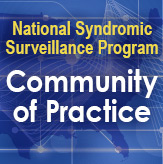Community of Practice Updates
- Request to Join NSSP CoP Slack®* Workspace**Share info with peers, plan projects, and accelerate data analysis.
- NSSP CoP WebsiteCheck calendar, join community groups, and link to state and other resources.
- CoP MembershipJoin or update member info. Membership is independent of CSTE, voluntary, and free!
- Knowledge RepositoryFind resources on syndromes, data analytics, data sharing, and related topics.
- CoP Call RecordingsIncludes monthly CoP meetings (slides, recordings) and subcommittee calls.
- Success StoriesSubmit success story or request help from CSTE team.
*If you have questions about the NSSP CoP, its highly collaborative user groups, the NSSP CoP Slack Workspace (a collaboration platform), or syndromic surveillance, please email syndromic@cste.org.
Community Highlights
NSSP Community of Practice Monthly Call
Acting Program Lead Karl Soetebier kicked off the discussion during the January 2022 Community of Practice (CoP) call:
- NSSP is committed to advancing CDC’s Data Modernization Initiative. Our commitment affects how we improve the utility of the BioSense Platform—its technical architecture (by adding new data sources and improving the representativeness of existing data sources)—and how we advance the Platform’s analytic capabilities.
- We want to thank the many community members who collaborated with the Council of State and Territorial Epidemiologists (CSTE), which also facilitates the NSSP Community of Practice (CoP), to identify potential data sources for integration into NSSP. CSTE has nearly completed the report and will share it with the community once finalized.We have already started using this work in a second effort led by the MITRE group. MITRE works with government agencies to tackle challenging problems that affect the nation’s well-being. MITRE is developing profiles of these data sources to convey the public health value of each and assessing the technical, policy, and cost implications of integrating these data sources into the BioSense Platform.
- We are ramping up efforts to complete the work we started last summer to address training gaps. Also, we continue to add training items to the NSSP CoP Knowledge Repository (KR) and are working with CSTE to improve the KR’s functionality. Revisions to the KR are scheduled for spring 2022; the trainings will take longer to implement.
- We continue to look for ways to improve the NSSP BioSense Platform so that it meets members’ current (and upcoming) needs even better. (For details, see this month’s Technical Updates.)
Announcements
During the January 2022 NSSP Community of Practice (CoP) Call, we welcomed new members and gave an overview of the CoP’s offerings. We introduced the Core Committee, subcommittees, user groups, and workgroups and described the role each played in advancing the community’s surveillance goals. We also demonstrated how members can access and use CoP resources such as the NSSP CoP Website, Slack Workspace, Knowledge Repository, and NSSP Technical Resource Center.
Recordings for the monthly CoP calls are located here: https://kr-drupal.syndromicsurveillance.org/community-practice-monthly-calls. Or you may directly access the January 2022 Orientation to the NSSP Community of Practice recording and slides.

It’s easy to join. And the community is always exchanging ideas, exploring possibilities, and discussing topics relevant to today’s surveillance challenges.
So what are your colleagues discussing?
- #analytic-tools
- #chief-complaint-processing
- #covid19
- #data-quality
- #data-sharing
- #drug-overdose-use
- #environmental-health-and-severe-weather
- #essence-user
- #general
- #hospital-admission
- #lab-data
- #mortality-data
- #national-data-requests-sop
- #new-member-orientation
- #nssp-cop
- #planned-analyses-and-publications
- #race-and-ethnicity
- #random
- #r-user
- #sas-user
- #spherr
- #syndrome-definitions
- #technical
- #training
- #violence-surveillance
Find and Join Channels
- Hover cursor over “Channels” on left side of Slack space.
- Click the three dots icon that appears next to “Channels” titled “Section Options.”
- Select “Browse Channels.”
- Find and join any channel that looks interesting!

“Modernization” of our public health data and surveillance systems is one way in which CDC invests in the future of public health.
The CDC Public Health Data Modernization Initiative lays out a path to move us toward integrated systems that provide data more efficiently for public health action. This framework guides decisions for allocating resources to create interoperable systems (federal, state, local, and healthcare), coordinate investments across CDC (and with partners), develop next-generation tools (e.g., modeling, visualization, machine learning), and strengthen predictive analytics and forecasting. One objective of DMI is for syndromic surveillance to give a faster understanding of emerging health threats through electronic reporting of emergency department visits.
“This is a moment in time when our national leaders will seek to identify or build platforms to detect and monitor future health threats,” NSSP Lead Loren Rodgers said during a 2021 NSSP Community of Practice call. “I’d like to challenge the NSSP community to consider our place in a new public health infrastructure. I don’t know of another program that is so purpose-built for this task with the ability to scale to include new data sources and analytics and to share these data with allied [public health] jurisdictions and trusted partners. Our syndromic community exemplifies innovative approaches that other surveillance systems aim to implement.”
CDC’s earlier modernization efforts laid the groundwork that supports NSSP’s current approach to surveillance and—bolstered by CDC’s Data Modernization Initiative—positions the program to better protect our country from all types of public health threats.
